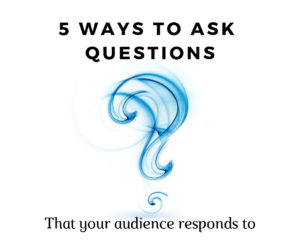Do you give presentations, and worry about how to ask questions that your audience responds to? Have you ever sweated through silence, while a lot of faces stared blankly at you? It’s probably happened at some point – it certainly has to me!


1. The opening of your talk
I often encourage my clients to ask a question in their opening few sentences – because it is a good engagement technique. Some speaking coaches nowadays say that it’s cliched, but it’s a cliche for a reason. So long as it’s a relevant question, it works.
However you need to ask in the right way, because the audience – if they don’t know you – probably don’t trust you yet or know you well enough to be willing to reply.
So in this case I recommend asking a rhetorical question (which is really a statement from you, phrased as a question) rather than a ‘real’ one, which expects a verbal response.
Something like “you know what it’s like when you can’t think what to say next when you’re speaking in public…?” or “have you ever experienced a brain freeze or mind blank during your presentation?”.
These are gentle openers: they’re closed-ended questions, and the audience can nod if they like, or stay silent, or smile, or show discomfort.
You’re not expecting any more from them than that, so they can stay in their own safe bubble…OR choose to interact with you at their own level.
2. Direct them, so they’re clear
You are also going to need to direct them so that they know what you want from them, and they’re not afraid of looking stupid.
For a rhetorical question you could say something like “Show of hands…who knows our latest figures on…?”, or “let me take a quick poll – how many of you are aware of our latest engagement figures?”
Or if you’re looking for a direct, out-loud reply, try for example “let me ask you a question…and I’d love you to tell us out loud here, what you think”.
As audience members, we’re often overwhelmed and tired, and we really don’t want to have to think too hard. As the speaker and controller of the room, take care of your audience.
Tell them clearly what you would like them to do, and they’ll be grateful! (Without sounding as though you’re lecturing, or being patronising of course! This comes down to your tone.)
3. Wait for responses
You seriously need to allow time for your audience to think about the question and formulate a response.
Particularly if it’s a complex question, where they need to weigh up their opinions or compare ideas in their mind.
Remember that a good presentation allows for reflection time. And personally I find it so frustrating when a speaker rushes through their content, or asks a question and then moves straight on and answers it themselves without giving me time to think.
I’m also an introvert so I will think before I speak, and I need time to process. [See here for a great Time article on how introverts process] Plus there are nervous people potentially, weighing up whether or not they’ll sound stupid. You may need to wait 6 – 8 seconds, and this will seem like a really long time!
You can fill in the time by counting silently in your head or squeezing your toes – try one squeeze per second.
And of course you’re going to stay looking alert, with an encouraging expression on your face! Smile, look happy to be there… and direct your gaze gently to different parts of the audience.
Which leads me to my fourth point.
4. Encourage your audience to respond
Talking of encouraging…you want to create a safe environment for your audience if you can (of course e.g. some corporate culture or environments may be out of your control, but hopefully safety is at least partly possible!).
So you might even like to make a comment such as “there are no wrong answers here”, or “feel free to give us any idea that comes to your mind”.
And of course, make sure that you use some of their responses as you go through your presentation. When an audience sees you referring back to a previous audience member’s idea, and weaving this into your talk, they will feel even more connected to you.
This increases their engagement level. And if you’re afraid that you might forget some replies, you can jot down notes perhaps as you go.
Or if you’re running a workshop, write ideas up on the whiteboard or flip chart (or get someone else to do it).
5. If there’s silence
On some days, your audience may just not be willing to come to the party. If you do ask a question, and despite your best efforts no-one is willing to reply, here are a couple of ideas. Say:
- “Well, what people sometimes respond with, is…”
- “Well you might want to think about this one over time.” You need to say this with confidence, or it will sound lame. I recommend that you practise it out loud on your own!
I hope these ideas on how to ask questions that your audience responds to has been helpful! For more on this topic, check out this post focused on your inner dialogue asking yourself questions to influence your audience.
Best wishes with your presentations or public speaking!